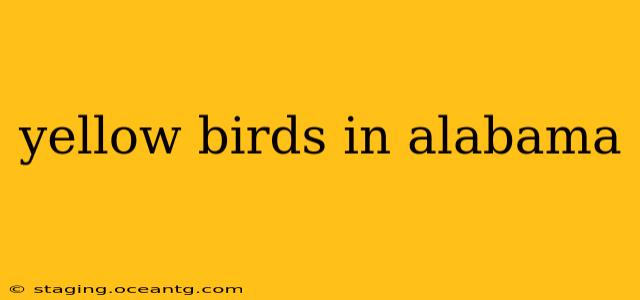Alabama, with its diverse ecosystems ranging from coastal plains to the Appalachian foothills, boasts a vibrant bird population. Among the most eye-catching are the yellow birds that grace the state's skies and woodlands. This guide will explore the various species of yellow birds found in Alabama, helping you identify them and appreciate their ecological roles. We’ll also answer some frequently asked questions about these beautiful creatures.
What are some common yellow birds in Alabama?
Several species of yellow birds call Alabama home, each with unique characteristics. Some of the most common include:
-
Northern Flicker: While not entirely yellow, the Northern Flicker displays striking yellow shafts on its underparts and a yellow rump patch, easily noticeable in flight. These woodpeckers are frequent visitors to backyards and woodlands.
-
American Goldfinch: This tiny bird is a vibrant, cheerful yellow during the breeding season, with males showing a more intense coloration. They're often seen flitting amongst wildflowers and feeding on seeds.
-
Yellow-rumped Warbler (Myrtle Warbler): The Yellow-rumped Warbler is a common winter resident in Alabama, showing a bright yellow rump and flanks, distinguishing it from other warblers. Its cheerful song adds to the winter soundscape.
-
Yellow-throated Warbler: This warbler boasts a bright yellow throat and breast, with olive-green upperparts. It’s a less common sight than the Yellow-rumped Warbler but still a welcome addition to Alabama's avian diversity.
What is the most common yellow bird in Alabama?
Pinpointing the single most common yellow bird is difficult due to variations in seasonal migration patterns and habitat preferences. However, based on widespread observations and bird surveys, the Yellow-rumped Warbler and the American Goldfinch are strong contenders for the title. Their adaptability and presence throughout different seasons make them frequently encountered species across various habitats in Alabama.
What are some less common yellow birds found in Alabama?
While the species mentioned above are relatively common, several less frequently seen yellow birds can also be found within the state's borders. These include:
-
Prothonotary Warbler: This stunning bird is a bright, rich yellow with blue-gray wings. It's a more localized species, favoring swamps and bottomland forests, making encounters less frequent.
-
Summer Tanager: The male Summer Tanager is a vibrant crimson-red, but some individuals show yellow tints, especially younger birds or those molting. While the red coloration is more prominent, its occasional yellow tones merit its inclusion here.
Where can I find yellow birds in Alabama?
The best places to spot yellow birds in Alabama depend on the specific species. However, some general guidelines apply:
-
Woodlands and Forests: Look for woodpeckers like the Northern Flicker and warblers like the Yellow-rumped and Yellow-throated warblers in various forested areas.
-
Backyards and Parks: American Goldfinches are frequent visitors to feeders and areas with wildflowers, often found in residential areas and parks.
-
Wetlands and Swamps: The Prothonotary Warbler favors swampy habitats and bottomland forests, so these areas offer the best chance of encountering this striking bird.
What time of year is best for birdwatching in Alabama?
Migration seasons, spring and fall, are ideal times for birdwatching in Alabama. During these periods, numerous species, including many of the yellow birds mentioned, pass through the state. Winter also offers opportunities to see resident and wintering species like the Yellow-rumped Warbler. Summer is excellent for spotting breeding birds engaged in courtship and nesting behaviors.
This guide provides a starting point for your exploration of Alabama’s yellow birds. Remember to use binoculars for a better viewing experience and consider joining a local birding group to enhance your knowledge and connect with fellow bird enthusiasts. Happy birdwatching!
